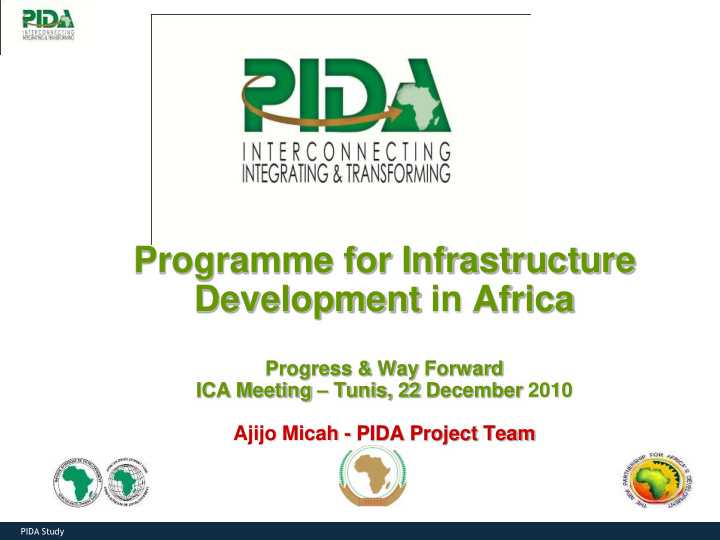



led consortium led consortium Programme for Infrastructure Development in Africa Progress & Way Forward ICA Meeting – Tunis, 22 December 2010 Ajijo Micah - PIDA Project Team PIDA Study PIDA Study
led consortium PIDA STUDY STRUCTURE PIDA is structured in three phases of work in addition to Ince ption Phase: Phase I : Diagnostic, analytical work and projections Phase II : Formulation of Strategic framework , PIDA GOVERNANCE infrastructure development programmes and implementation arrangements Phase III: Synthesis & Recommendations 2 PIDA Study
led consortium INCEPTION PHASE PHASE I PHASE II WHERE STUDY IS INCEPTION KICK OFF VALIDATION SECTOR & REGIONAL PHASE I REPORT PHASE WORKSHOPS WORKSHOP DELIVERY WORKSHOP Inception PRESENTATION METHODO. PHASE I REPORT PHASE II OF THE IR BRIEF Report Johannesbur 5 th July Second Quarter g Fisrt Quarter 2011 2011 2010 30 th July 2010 PIDA Study
led consortium PIDA STUDY STRUCTURE Phase I – Diagnostic & Analysis Presented during the METHODOLOGICAL BRIEF validation Workshop Jo’burg, 30 Sept 2010 REVIEW OF CONTINENTAL AND REGIONAL POLICIES REVIEW OF EXISTING PROJECTS Underway To be completed First Quarter 2011 OUTLOOK FOR THE FUTURE OUTLINE OF DEVELOPMENT PROGRAMME PHASE I REPORT PIDA Study
led consortium . STUDY STRUCTURE : Vision: INCEPTION PHASE Interconnected/ integrated Infrastructure network & ( 29-30 JULY 2 010) services critical for sustainable social and economic development of Africa as an Inception economic bloc & for effective participation in global economy Report by the Core Principles: Consultant * Open Regionalism * Sub-sidiarity Thematic * Leveraging sovereignty for mutual benefits notes: by panel * Focus on strategic projects of experts with high potential for regional cooperation & devt. impacts PIDA Study
led consortium OUTLOOK FOR FUTURE DEMAND DEMAND Demand for infrastructure services (over 2010-2040) is derived from GDP growth and the development of growth poles (agriculture , mining & services). GROWTH The growth rate for the continent is assumed to average 6% per annum in real terms. MODELING TOOL The Augmented Solow model is used to distribute the increased wealth according to growth drivers . 6 PIDA Study
led consortium SIMULATION TOOL GDP POPULATION LABOUR PRODUCTIVITY CAPITAL QUALITY TECHNICAL ACCUMULATION OF LABOUR PROGRESS PIDA Study
led consortium OUTLOOK FOR FUTURE DEMAND FOR REGIONAL INFRASTRUCTURE Demand in each sector is derived as follows: • Link trade, GDP and population growth in a direct TRANSPORT demand model per Transport Corridor ENERGY • Elasticity to GDP policies for Increased Access Rate • Based on Traffic projections taking into account ICT the population growth rate and increased access and connectivity • Needs in terms of irrigation and domestic water TWR uses will be assessed on the basis of Population growth rate and Economic growth rates 8 PIDA Study
led consortium ESTIMATING SUPPLY RESPONSE TO REGIONAL INFRASTRUCTURE DEMAND Evaluating Supply response in each sector is derived as follows: Scope of existing regional and continental policies in each sector Policy Coherence Analysis/Policy gaps/Constraints Infrastructure Service level supply projections based on population growth rate, increased access and connectivity 9 PIDA Study
led consortium OUTLOOK FOR FUTURE DEMAND AND SUPPLY OF REGIONAL AND CONTINENTAL INFRATRUCTURE 10 PIDA Study
led consortium THE WAY FORWARD 11 PIDA Study
led consortium LED CONSORTIUM Programming: Analysis Factors A) Contribution to sustainable Development through Physical Integration: • Increased trade in goods & services 1. Economic • Attraction of Private Sectors in the REC as hub Dimension • Increase in competitiveness of the REC 2. Social • Creation of employment and income Dimension • Improve the population standard of living 3. • Natural Resources conservation Environmental • Environmental Quality Dimension PIDA Study
led consortium LED CONSORTIUM Programming: Analysis Factors B) Feasibility Factors: • Institutional & Regulatory Framework 1. Feasibility • Consistency of current and future demands Elements • Environmental risk mitigation possibilities • Operation & Execution conditions 2. Financing • Capacity to attract private and /or public investment & PPP 3. Political • Degree & symmetry of partners state convergence on Convergence project & sustenance of priority over time PIDA Study
led consortium COOPERATION WITH STRATEGIC PARTNERS Cooperation and collaboration in the implementation of the PIDA projects portfolio; Projects preparation support for prefeasibility and detailed techno – economic studies including identification of environmental and social implications; Active involvement and support for policy dialogue; Support in establishment of collaborative mechanism/agreement; Sharing experiences from other regions in identifying possible challenges and opportunities Financial support 14 PIDA Study
led consortium LED CONSORTIUM MERCI OBRIGADO THANK YOU اركش PIDA Study
Recommend
More recommend